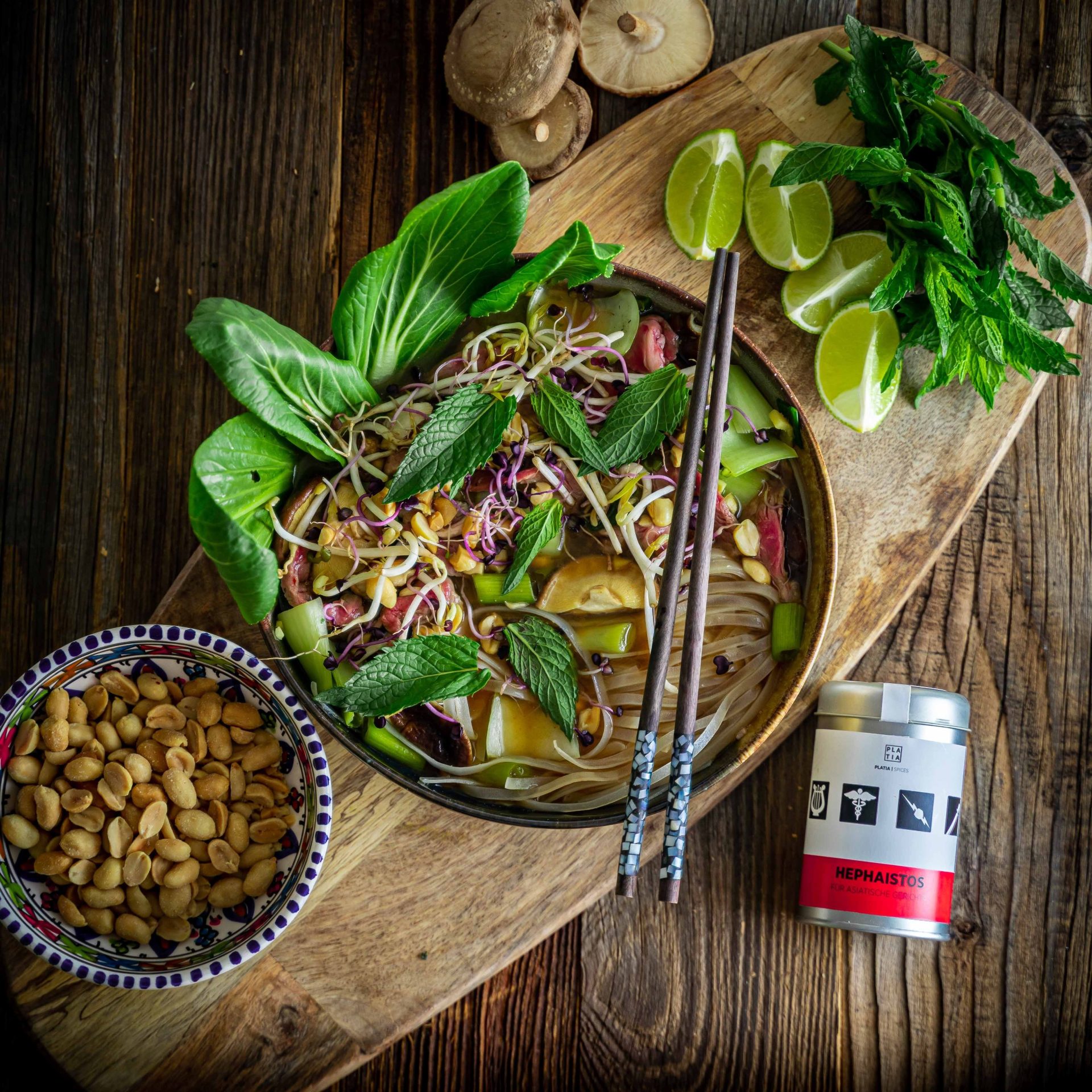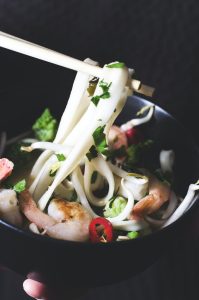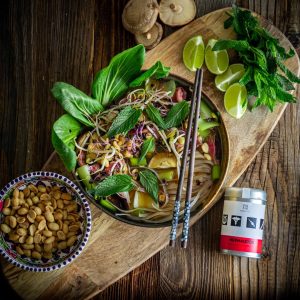Humans are the only living species that cook and all human cultures have some form of food processing. This is what sets us apart from the rest of the animal kingdom. What sets cultures apart is the way different nations have varied traditional ways of cooking. Food has become one of the most visible and powerful markers of cultural identity. When we eat, we ingest a culture’s principles and values—we literally consume its beliefs.
Traditional Vietnamese cuisine developed as a result of the tropical climate and resources made available by large rivers. The intense rainfall and water resources allowed for flourishing agriculture. With this came the abundance of rice, leafy greens, fruits, and vegetables. The country is also surrounded by bodies of water providing an abundance of seafood and fish, which are good sources of protein. The combination of these foods with other elements produces a variety in culinary taste and texture.
The sophistication of the Vietnamese kitchen produces simplicity.
Vietnamese kitchens are simpler than Western ones. There are specific utensils needed for cooking. The most important kitchen utensil is a large, oval-shaped iron pan (or wok), which distributes heat evenly for fast cooking and saves expensive fuel. It also maintains crispiness and nutritional value in foods that are stir-fried in them. A heavy cleaver and a wood cutting block are essential for chopping ingredients to be cooked by stir-frying. Pestles and mortars are the workhorses of traditional kitchens; they’re mainly used for pounding spices. Large chopsticks, ladles, and strainers do much of the rest. Gas stoves have replaced the traditional wood-fed hearth as the preferred method of cooking, and electric rice cookers are now used in place of an open flame.
The yin and yang of traditional Vietnamese cuisine.
Vietnamese cuisine is often based on the principle of yin and yang, which manifests itself in every dish. The four main flavors in Vietnamese cooking are salty, sour, sweet, and spicy. It is the balance of these four that makes Vietnamese cuisine so popular around the world. The balance of these flavors is a fundamental principle of Vietnamese cooking. The balance is achieved by using a combination of ingredients such as fish sauce, sugar, lime juice, and chili peppers.
Vietnamese cooking relies heavily on the use of fresh herbs and vegetables, which contributes to its balanced mix of flavors. Fresh herbs are often used as garnishes and are typically added at the end of cooking to preserve their crispness and flavor. Vietnamese cooks often use lemongrass, ginger, mint leaves, and coriander leaves in their cooking.
The use of fruits and vegetables also adds a balance of texture, color, and nutritional value. Many Vietnamese dishes are well-balanced in terms of macronutrients and micronutrients. Fruits and vegetables add visual appeal, variety in texture, and taste to a dish.
Another important aspect of balance in Vietnamese cuisine is the balance between different cooking methods. In traditional Vietnamese cooking, the yin and yang principle is translated into the cold-hot paradigm. Certain ingredients (such as ginger, and beef), cooking modes (frying), and dishes (fried beef with ginger) have inherent heating energy. Cooling foods include those with a sour or bitter taste and steamed dishes. The dishes themselves are not necessarily hot or cold, but their physical effect is heating or cooling. The “hot and cool” balance can also be applied to the greasiness of the meat served. If a dish is too greasy, then it must mean that more vegetables will help offset its unhealthiness.
The Traditional Vietnamese cooking culture is also heavily rooted in nature’s ways. The five elements theory suggests that the world and everything in it is composed of water, fire, wood, metal, and earth. With rice standing for earth (and center), soup for water, greens for wood, fish sauce for fire, and a dry dish for metal. This scheme also informs the five basic cooking modes: raw, steamed, boiled, fried/grilled, and fermented; the five tastes: spicy, sour, bitter, salty, and sweet; and the five textures: crispy, crunchy, chewy, soft, and silky.
In traditional Vietnamese cooking, everything is present and balanced.
The foreign influences in Vietnamese cooking.
As with all cuisines, Vietnamese cuisine was deeply shaped by the country’s contact with other cultures. Vietnamese food has been greatly influenced by the Chinese, French and Indian cultures. The most important influence is from China, as it was the first nation to colonize Vietnam. In fact, many of the ingredients used in Vietnamese cooking are imported directly from China. These include soy sauce, black pepper, ginger, and noodles. Noodles, an invention of the Chinese, are a staple in the country’s cuisine. Rice was first domesticated in Southeast Asia, then introduced to China; however, the culinary influence moved back and
forth between regions.
In addition to the ingredients that were brought over by Chinese settlers and traders several centuries ago, Vietnamese cooking also draws on some native elements. Lemongrass, coriander leaves which gives foods a citrusy flavor similar to cilantro but with an aroma more like cinnamon or nutmeg; Thai basil which smells very fragrant; star anise which gives foods a sweet licorice aroma when cooked together with other ingredients such as cinnamon sticks or cloves; fish sauce made from fermented fish juice.
The second major culinary influence on Vietnamese cuisine came about during French colonization which lasted until 1954 when they lost their colony after losing World War II against both Germany and Japan. Vietnam’s cuisine is heavily influenced by French cooking, as exemplified in dishes such as baguettes with pork pate, yogurt, and coffee. There’s also lagu or ragu—a beef-onion-carrot-potato ragout served with a sliced baguette. This dish exemplifies culinary fusion, through a combination of styles and traditions. The resulting dish, cooked in a wok and seasoned with fish sauce, coconut milk, turmeric, and coriander creates an entirely new flavor profile than the French dish.
Vietnamese cuisine is a balance of many flavors, each contributing its own essence.
Traditional Vietnamese cooking relies heavily on fresh ingredients and minimal preparation. The cuisine features lots of leafy greens, fish, very limited amounts of animal protein and fat—and moderate use of sugar. By reducing meat consumption, farming systems in Vietnam would place less pressure on dwindling ecological resources and result in less pollution.
Vietnamese cuisine is all about balance. To get a perfect dish, you need to make sure that every ingredient has its place and role to play. The most important thing is the freshness of ingredients because it brings out all the flavors from different elements in your dish. The flavors in Vietnamese food include salty, sour, sweet, and spicy—but one taste doesn’t overpower another or make your mouth feel like there’s nothing going on.
We hope you enjoyed this brief history of Vietnamese cuisine. It is one of the most dynamic and exciting cuisines in the world, incorporating many different flavors and influences from around Asia.





